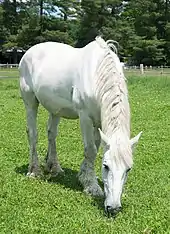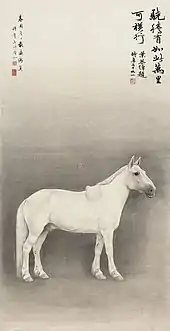When a white horse is not a horse
When a white horse is not a horse is a paradox in Chinese philosophy attributed to Gongsun Long, a philosopher of the Warring States period. It appears in the form of a dialogue between two unnamed speakers who debate the proposition "a white horse is not a horse".
| When a white horse is not a horse | |||||||||
|---|---|---|---|---|---|---|---|---|---|
| Traditional Chinese | 白馬非馬 | ||||||||
| Literal meaning | white horse is not horse | ||||||||
| |||||||||
The original text
The dialogue constitutes a chapter of the eponymous Gongsun Longzi. The purported author, also known as "Master Gongsun Long" (fl. 284–259 BCE),[1] was counted among the School of Names in the Hundred Schools of Thought. Most of Gongsun's writings have been lost; the received Gongsun Longzi text contains only six of the supposed 14 original chapters. Parts of the text are dislocated; thus, some commentators and translators rearrange them for clarity. The dialogue is between two unnamed speakers:

Is "a white horse is not horse" assertible?
Advocate: It is.
Objector: How?
Advocate: "Horse" is that by means of which one names the shape. "White" is that by means of which one names the color. What names the color is not what names the shape. Hence, one may say "white horse is not horse."
Objector: If there are white horses, one cannot say that there are no horses. If one cannot say that there are no horses, doesn't that mean that there are horses? For there to be white horses is for there to be horses. How could it be that the white ones are not horses?
Advocate: If one wants horses, that extends to yellow or black horses. But if one wants white horses, that does not extend to yellow or black horses. Suppose that white horses were horses. Then what one wants [in the two cases] would be the same. If what one wants were the same, then 'white' would not differ from 'horse.' If what one wants does not differ, then how is it that yellow or black horses are acceptable in one case and unacceptable in the other case? It is clear that acceptable and unacceptable are mutually contrary. Hence, yellow and black horses are the same, one can respond that there are horses, but one cannot respond that there are white horses. Thus, it is evident that white horses are not horses.
— "2:白馬論", 公孫龍子
This dialogue continues with deliberations over colored and colorless horses and whether white and horse can be separated from white horse.
Other Gongsun Longzi chapters discuss "white horse"-related concepts of: jian 堅 'hard; hardness', and bai 白 'white; whiteness', ming 名 'name; term', shi 實 'solid; true, actual; fact, reality', the abstract zhi 指 'finger; pointing; designation; universal' (like "whiteness"), and the concrete wu 物 'thing; object; particular' (like "a white horse").
Interpretations and proposed solutions
The 'paradox' can be resolved by recognizing that the lack of articles in the Chinese language contributes to semantic ambiguity. Without grammatical articles, it is unclear whether each 'horse' (馬) in the statement "A white horse is not a horse" refers to 'a horse', 'the (desired) horse', 'all horses', or 'horsekind'. This can be seen clearly by expressing the paradox in English using articles: suppose that one desires yellow or black horses, then a white horse would not be the (desired) horse. The Advocate's sophistry in the White Horse Dialogue is due to his confounding 'a horse' with 'the (desired) horse'.
According to A. C. Graham,[2] this "A white horse is not a horse" paradox plays upon the ambiguity of whether the 'is' in the statement means:
In other words, the expression "white horse is not horse" is ambiguous between "white horse is not synonymous with horse" (true because white horse is more specific than horse), versus "a white horse is not a member of the set of horses" (obviously false). The Advocate in the dialogue is asserting a lack of identity between horses and white horses, while the Objector is interpreting the Advocate's statement as a claim that the category of horses does not include white ones.
Beyond the inherent semantic ambiguities of "A white horse is not a horse," the first line of the White Horse Dialogue obscurely asks 可乎 ('Can it be that ...?'). This dialogue could be an attempted proof that a white horse is not a horse, or a question if such a statement is possible, or both. Bryan W. Van Norden suggests that "the Advocate is only arguing that 'a white horse is not a horse' could be true, given a certain interpretation. He might acknowledge that, in another interpretation, 'a white horse is a horse.'"[3]
An alternative interpretation is offered in Feng Youlan's A History of Chinese Philosophy:[4]
Strictly speaking, names or terms are divided into those that are abstract and those that are concrete. The abstract term denotes the universal, the concrete term the particular. The particular is the denotation, and the universal the connotation, of the term. In western inflected languages there is no difficulty in distinguishing between the particular ('white' or 'horse') and the abstract ('whiteness' or 'horseness'). In Chinese, however, owing to the fact that the written characters are ideographic and pictorial and lack all inflection, there is no possible way, as far as the form of individual words is concerned, of distinguishing between abstract and concrete terms. Thus in Chinese the word designating a particular horse and that designating the universal, 'horseness,' are written and pronounced in the same way. Similarly with other terms, so that such words as 'horse' and 'white', being used to designate both the concrete particular and the abstract universal, thus hold two values.
However, there are recent histories of Chinese philosophy that do not subscribe to Feng's interpretation. Other contemporary philosophers and sinologists who have analyzed the dialogue include A. C. Graham,[5] Chad Hansen,[6][7] Cristoph Harbsmeier,[8] Kirill Ole Thompson,[1] and Bryan W. Van Norden.[3]
Historic influence

In the Chinese philosophical tradition, the White Horse Dialogue's significance is evident from the number of Chinese classic texts directly or indirectly discussing it. The Liezi, which lists and criticizes the paradoxes of Gongsun Long as "perversions of reason and sense", explains "'A white horse is not a horse' because the name diverges from the shape."[9]
Two Zhuangzi chapters (17 and 33) mock Gongsun Long, and another (2) combines his zhi 指 'attribute' and ma 馬 'horse' notions in the same context:[10]
To use an attribute to show that attributes are not attributes is not as good as using a nonattribute to show that attributes are not attributes. To use a horse to show that a horse is not a horse is not as good as using a non-horse to show that a horse is not a horse, Heaven and earth are one attribute; the ten thousand things are one horse.
The Mengzi (6A4) notes that bai 白 'white' has different connotations whether one is using it to refer to a graying person (who is worthy of respect because of his or her age) or a white horse (which should be treated like any other animal):[11]
Mencius said, 'There is no difference between our pronouncing a white horse to be white and our pronouncing a white man to be white. But is there no difference between the regard with which we acknowledge the age of an old horse and that with which we acknowledge the age of an old man? And what is it which is called righteousness? The fact of a man's being old? Or the fact of our giving honor to his age?'
Other early "a white horse is not a horse" references are found in the Hanfeizi (32), Mozi (11B), and Zhanguoce (4).
Notes
- Thompson, Kirill Ole (1995). "When a 'White Horse' Is Not a 'Horse'". Philosophy East and West. 45 (4): 481–499. doi:10.2307/1399790. JSTOR 1399790.
- Graham, Angus Charles (1990); Studies in Chinese Philosophy and Philosophical Literature, p. 334, p. 334, at Google Books.
- Van Norden, Bryan (2011). Introduction to Classical Chinese Philosophy. Indianapolis: Hackett Publishing Company. p. 111. ISBN 9781603844680.
- Feng Youlan (1952) [1934]. A History of Chinese Philosophy. Translated by Derk Bodde. Princeton University Press. p. 206.
- Graham, Angus Charles (1989). Disputers of the Tao: Philosophical Argument in Ancient China. pp. 75–95.; Graham, (1990). Studies, pp. 125–216., p. 125, at Google Books
- Hansen, Chad (1976). "Mass Nouns and 'A White Horse Is Not a Horse'". Philosophy East and West. 26 (2): 189–209. doi:10.2307/1398188. JSTOR 1398188.
- Hansen, Chad (1983). Language and Logic in Ancient China. p. 140.
- Harbsmeier, Christoph (1998). "Language and Logic in Traditional China". Science and Civilisation in China. Vol. 7, Part I. pp. 298–321.
- Graham, p. 80., p. 80, at Google Books
- Zhuangzi. Zhuangzi: Basic Writings, tr. and ed. Burton Watson (2003), Columbia University Press; p. 35., p. 35, at Google Books
- Legge, James (1895); The Chinese Classics: a Translation, Part 2: "The Works of Mencius", p. 398., p. 398, at Google Books
References
- Fung, Yu-lan (1953). A History of Chinese Philosophy. Translated by Bodde, Derk. Princeton University Press. OCLC 3583254.
- Graham, Angus Charles (1989). Disputers of the Tao: Philosophical Argument in Ancient China. La Salle, Illinois: Open Court Press. ISBN 978-0-8126-9088-0. OCLC 19554332.
- Graham, Angus Charles (1990). Studies in Chinese Philosophy and Philosophical Literature. Albany: State University of New York Press. ISBN 9780791404492. OCLC 21043695.
- Hansen, Chad (1976). "Mass Nouns and 'A White Horse Is Not a Horse'". Philosophy East and West. 26 (2): 189–209. doi:10.2307/1398188. JSTOR 1398188.
- Hansen, Chad (1983). Language and Logic in Ancient China. Ann Arbor: University of Michigan Press. ISBN 9780472100200. OCLC 8590314.
- Harbsmeier, Christoph (1998). "Language and Logic in Traditional China". In Needham, Joseph (ed.). Science and Civilisation in China. Vol. 7, Part I. Cambridge University Press.
- Ivanhoe, Philip. J.; Van Norden, Bryan W. (2005). Readings in Classical Chinese Philosophy (2nd ed.). Indianapolis: Hackett Publishing. ISBN 9780872207806. OCLC 440608439.
- Legge, James (1870). The Chinese Classics: A Translation. Vol. Part I. New York: Hurd and Houghton. OCLC 29370740.
- Thompson, Kirill Ole (1995). "When a 'White Horse' Is Not a 'Horse'". Philosophy East and West. 45 (4): 481–499. doi:10.2307/1399790. JSTOR 1399790.
- Van Norden, Bryan W. (2005). "On the White Horse". In Ivanhoe, Philip J.; Van Norden, Bryan W. (eds.). Readings in Classical Chinese Philosophy (2nd ed.). Indianapolis: Hackett Publishing. pp. 363–368.
- Van Norden, Bryan W. (2011). "Language and Paradox in the 'School of Names'". Introduction to Classical Chinese Philosophy. Indianapolis: Hackett Publishing. pp. 102–119. (Includes a section titled "On the White Horse".)
- Zhuangzi; Chuang Tzu (1964). Watson, Burton (ed.). Zhuangzi: Basic Writings. Translated by Watson, Burton. New York: Columbia University Press. OCLC 559127601.
External links
- 白馬論 "The White Horse Dialogue", CText.org, Chinese Text Project